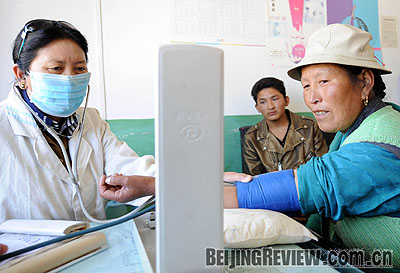|
 MEDICAL HELP: The government pledges to invest more budget to improve the medicare system in rural areas
MEDICAL HELP: The government pledges to invest more budget to improve the medicare system in rural areas
China’s vast countryside will bear witness to a new round of development after three decades of opening up and development.
The Third Plenary Session of the 17th Central Committee of the Communist Party of China (CPC), held on October 9-12 in Beijing, approved a decision on major issues concerning rural reform and development, and nailed down guidelines, goals and major principles at the close of the four-day plenum. The decision will serve as a guidance document for the reform and development in China’s rural areas now and in the coming years.
What are the messages the plenum hoped to convey through its decision? How will China launch a new-round rural reform? And how can the vast countryside better develop the rural economy? What are the targets set for them? Several scholars and experts have analyzed the communiqu to answer these questions.
Sober evaluations
The communiqu excerpts: We believe new changes are brewing in China’s rural areas. The agricultural sector is facing changing conditions for international cooperation and competition. Favorable conditions coexist with parallel difficulties and challenges, especially those related to the contradictions within the urban-rural dichotomy, for advancing rural reform and development efforts. We have to reinforce the weak infrastructure of the agricultural sector, offer support to the rural areas to back up greater economic strides there, and speed up the income increase for farmers. We must get fully prepared for the worst while staying safe, step up our efforts and constantly reinforce and expand the strong development momentum in rural areas.
We believe China has entered a new phase of development by encouraging the industrial sector to support the agricultural sector and urban areas to support rural areas. China is at a crossroad of speeding up traditional agriculture transformation and boosting modern agriculture with Chinese characteristics, and it needs to smash the urban-rural dual structure of development and form an integrated and balanced pattern for urban and rural areas in terms of economic and social development.
Deng Dacai (professor at the Research Center of China Rural Issues at East China Normal University): It’s the CPC Central Committee’s new outlook on where China is in its development course. The rural economy has been regarded as a source of capital accumulation for industrialization and urbanization for quite a long period in the past, while the fact that the communiqu gave priority to the development of rural economy this time marked the end of a period when agriculture, the countryside and farmers contributed and gave way to industrialization and urbanization, and the beginning of a new phase of the industrial sector supporting the agricultural sector and cities helping the countryside to develop.
Chen Xiwen (Director of the Office of the Central Leading Group on Rural Work): The rural reform that began three decades ago has brought historical changes to the outlook of China’s vast countryside, but there are still challenges and problems for rural reform and development ahead. Noticeable contradictions within the urban-rural dual development structure prevent us from making further progress in creating an integrated pattern of social and economic development in urban and rural areas. The extensive development in the agriculture sector makes it even more difficult to ensure steady development in this sector. A mechanism to promote steadily increasing incomes for farmers is yet to be established, and the urban-rural income disparity is widening. Many remote, backward rural villages are developing very slowly, which makes the task of offering equal access to urban and rural residents for basic public services a tough one to accomplish.
Li Heng (analyst at TX Investment Consulting Co. Ltd.): I believe that the decision reached at the session on rural reform and development will have an influence on fixed assets investment, rural consumption, economic growth and income allocation.
The fixed assets investment in the countryside has accounted for a small portion of the total social fixed assets investment since 1996, down from 23.3 percent in 1996 to 14.4 percent in 2007, which is seen to be largely responsible for the slower development of China’s countryside compared to cities. We forecast that the government will increase budget investment in rural infrastructure, transportation in particular, medicare facilities and education, and work out policies to boost rural fixed assets investment after the session.
| 